traction control MERCEDES-BENZ CLA 2018 Owners Manual
[x] Cancel search | Manufacturer: MERCEDES-BENZ, Model Year: 2018, Model line: CLA, Model: MERCEDES-BENZ CLA 2018Pages: 326, PDF Size: 7.97 MB
Page 6 of 326
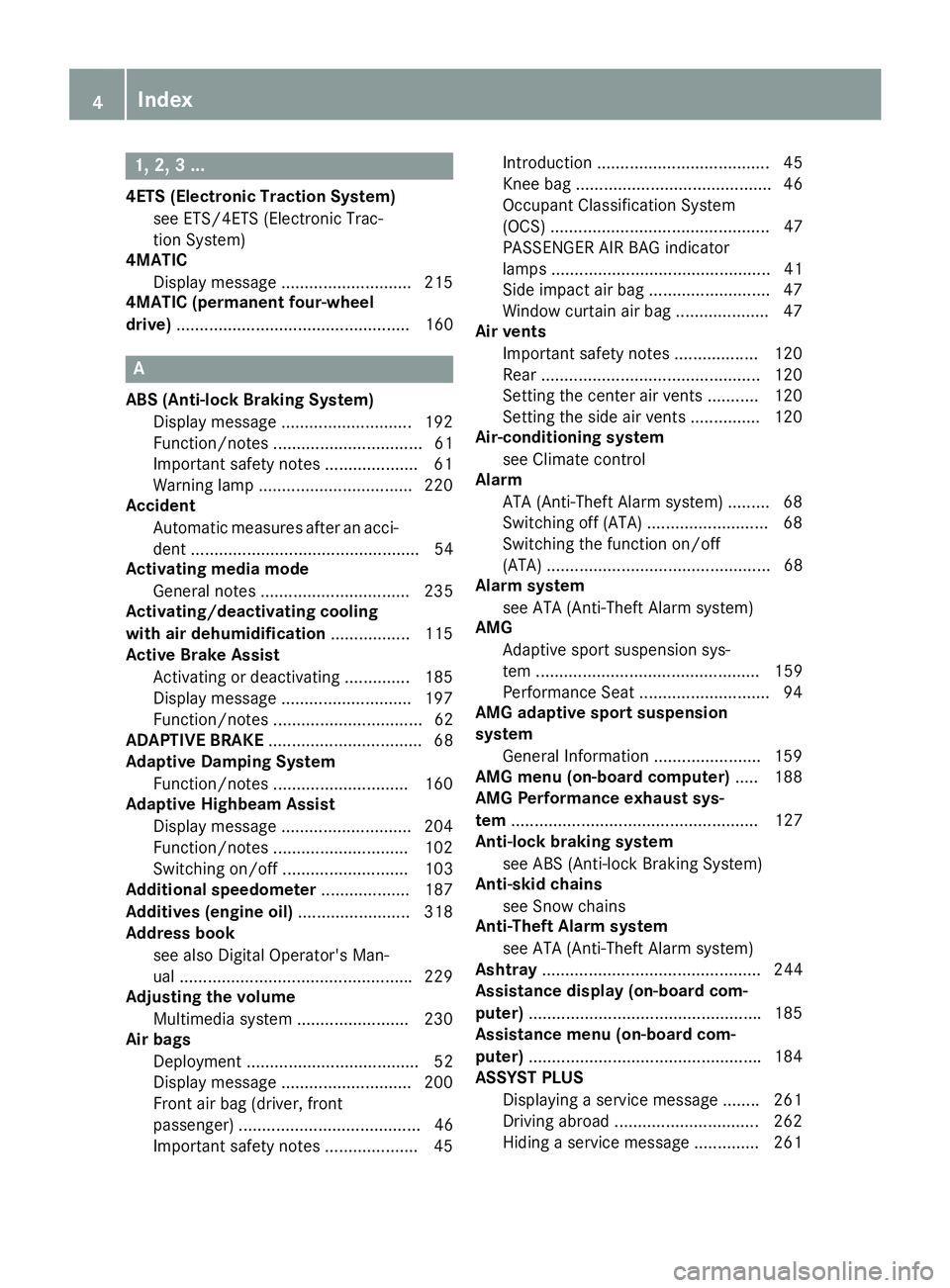
1, 2, 3. ..4ETS (Electronic Traction System)
see ETS/4ETS (Electronic Trac-
tion System)
4MATIC
Display message ............................ 215
4MATIC (permanent four-wheel
drive) .................................................. 160
AABS (Anti-lock Braking System)
Display message ............................ 192
Function/notes ................................ 61
Important safety notes .................... 61
Warnin gl amp ................................ .2 20
Accident
Automatic measure sa fter an acci-
dent ................................................. 54
Activatin gm edia mode
General notes ................................ 235
Activating/deactivating cooling
with air dehumidification ................. 115
Active Brake Assist
Activating or deactivating .............. 185
Display message ............................ 197
Function/notes ................................ 62
ADAPTIVE BRAKE ................................. 68
Adaptive Dampin gS ystem
Function/notes ............................ .1 60
Adaptive Highbeam Assist
Display message ............................ 204
Function/notes ............................ .1 02
Switching on/off ........................... 103
Additional speedometer ................... 187
Additives (engine oil) ........................ 318
Address book
see also Digita lO perator's Man-
ua l. ................................................ .2 29
Adjustin gt he volume
Multimedi as ystem ........................ 230
Ai rb ags
Deployment ..................................... 52
Display message ............................ 200
Front ai rb ag (driver, front
passenger ). ...................................... 46
Important safety notes .................... 45 Introduction ..................................... 45
Knee bag .......................................... 46
Occupant Classification System
(OCS) ............................................... 47
PASSENGER AIR BAG indicator
lamps ............................................... 41
Side impact ai rb ag .......................... 47
Windo wc urtai na ir bag .................... 47
Ai rv ents
Important safety notes .............. .... 120
R ea r. .............................................. 120
Setting the center ai rv ents ........... 120
Setting the sid ea ir vents .............. .1 20
Air-conditionin gs ystem
see Climate control
Alarm
ATA (Anti-Theft Alarm system) ......... 68
Switching off (ATA) .......................... 68
Switching the function on/off
(ATA) ................................................ 68
Alarm system
see ATA (Anti-Theft Alarm system)
AMG
Adaptive sport suspension sys-
tem ................................................ 159
Performance Seat ............................ 94
AMG adaptive sport suspension
system
General Information ....................... 159
AMG menu (on-board computer) ..... 188
AMG Performance exhaus ts ys-
tem ..................................................... 127
Anti-loc kb raking system
see ABS (Anti-lock Braking System)
Anti-skid chains
see Snow chains
Anti-Theft Alarm system
see ATA (Anti-Theft Alarm system)
Ashtray ............................................... 244
Assistanc ed isplay (on-board com-
puter) ................................................. .1 85
Assistanc em enu (on-board com-
puter) ................................................. .1 84
ASSYST PLUS
Displaying as ervice message ....... .2 61
Driving abroad ............................... 262
Hiding as ervice message .............. 2614
Index
Page 66 of 326
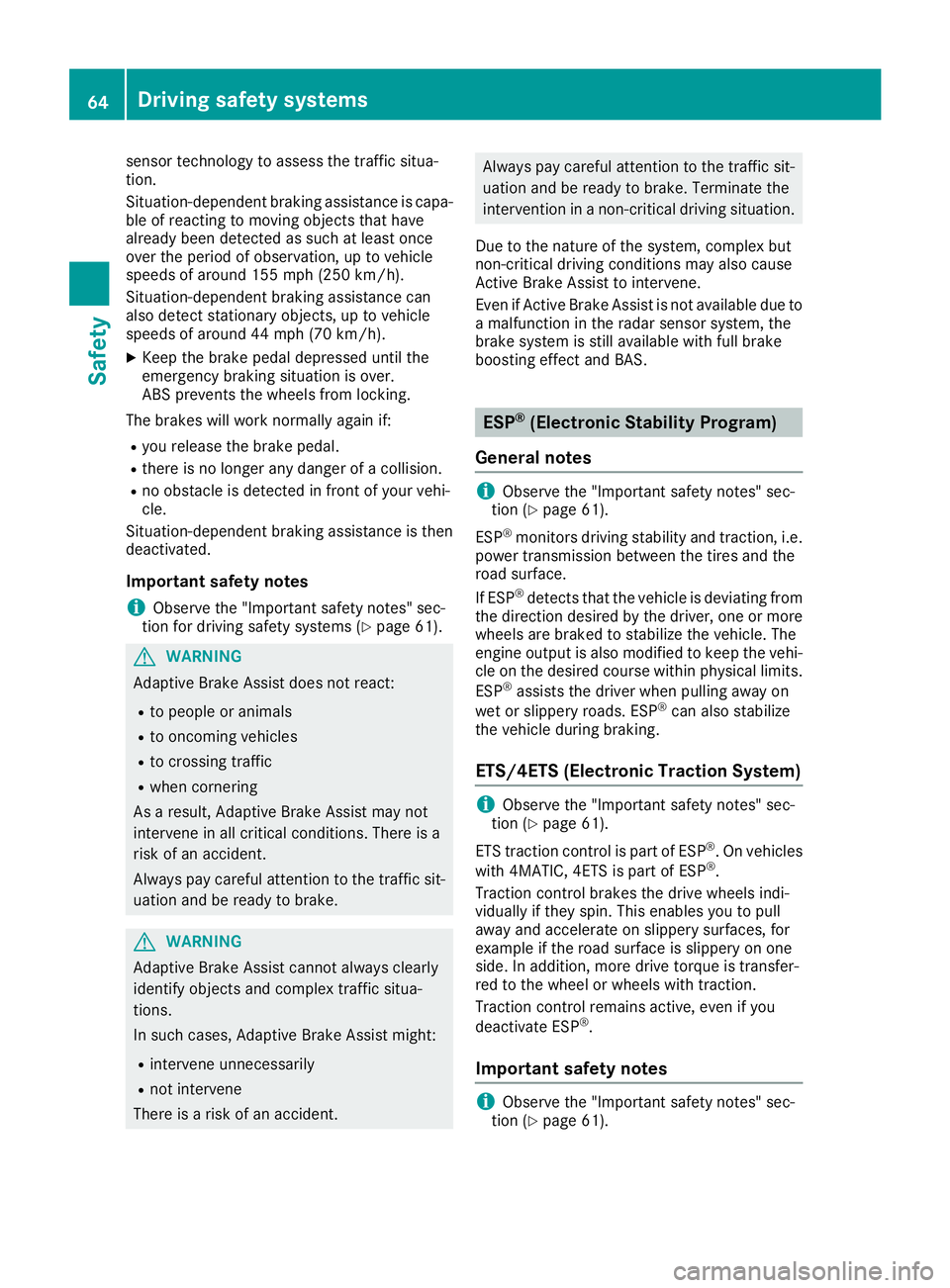
sensor technology to assess the traffic situa-
tion.
Situation-dependent braking assistance is capa-
ble of reacting to moving objects that have
alread yb een detected as such at least once
over the period of observation, up to vehicle
speeds of around 155 mph (250 km/h).
Situation-dependent braking assistance can
also detect stationary objects, up to vehicle
speeds of around 44 mph (70 km/h). X
Keep the brake pedal depressed until the
emergency braking situation is over.
ABS prevents the wheels from locking.
The brakes will work normally agai ni f:R
you release the brake pedal. R
there is no longer any danger of ac ollision.R
no obstacle is detected in front of your vehi-
cle.
Situation-dependent braking assistance is then
deactivated.
Important safety notes
i Observe the "Important safety notes" sec-
tion for driving safety systems ( Y
page 61).
G WARNING
Adaptive Brake Assist does not react: R
to people or animals R
to oncoming vehicles R
to crossing traffic R
when cornering
As ar esult, Adaptive Brake Assist may not
intervene in all critical conditions. There is a
risk of an accident.
Always pay careful attention to the traffic sit-
uation and be ready to brake.
G WARNING
Adaptive Brake Assist cannot always clearly
identify objects and complex traffic situa-
tions.
In such cases, Adaptive Brake Assist might: R
intervene unnecessarily R
not intervene
There is ar isk of an accident. Always pay careful attention to the traffic sit-
uation and be ready to brake. Terminate the
intervention in an on-critical driving situation.
Due to the nature of the system, complex but
non-critical driving conditions may also cause
Active Brake Assist to intervene.
Even if Active Brake Assist is not available due to
am alfunction in the radar sensor system, the
brake system is still available with full brake
boosting effect and BAS.
ESP ®
(Electronic Stability Program)
General notes
i Observe the "Important safety notes" sec-
tion ( Y
page 61).
ESP ®
monitors driving stability and traction ,i .e.
power transmission between the tires and the
road surface.
If ESP ®
detects that the vehicle is deviating from
the direction desired by the driver, one or more
wheels are braked to stabilize the vehicle. The
engine output is also modified to keep the vehi-
cle on the desired course within physical limits.
ESP ®
assists the driver when pulling awa yo n
wet or slippery roads. ESP ®
can also stabilize
the vehicle during braking.
ETS/4ETS (Electronic Traction System)
i Observe the "Important safety notes" sec-
tion ( Y
page 61).
ETS traction control is part of ESP ®
.Onv ehicles
with 4MATIC, 4ETS is part of ESP ®
.
Traction control brakes the drive wheels indi-
vidually if they spin. This enables you to pull
awa ya nd accelerate on slippery surfaces, for
example if the road surface is slippery on one
side. In addition, more drive torque is transfer-
red to the wheel or wheels with traction.
Traction control remains active, even if you
deactivate ESP ®
.
Important safety notes
i Observe the "Important safety notes" sec-
tion ( Y
page 61).64
Driving safety systems
Safety
Page 151 of 326
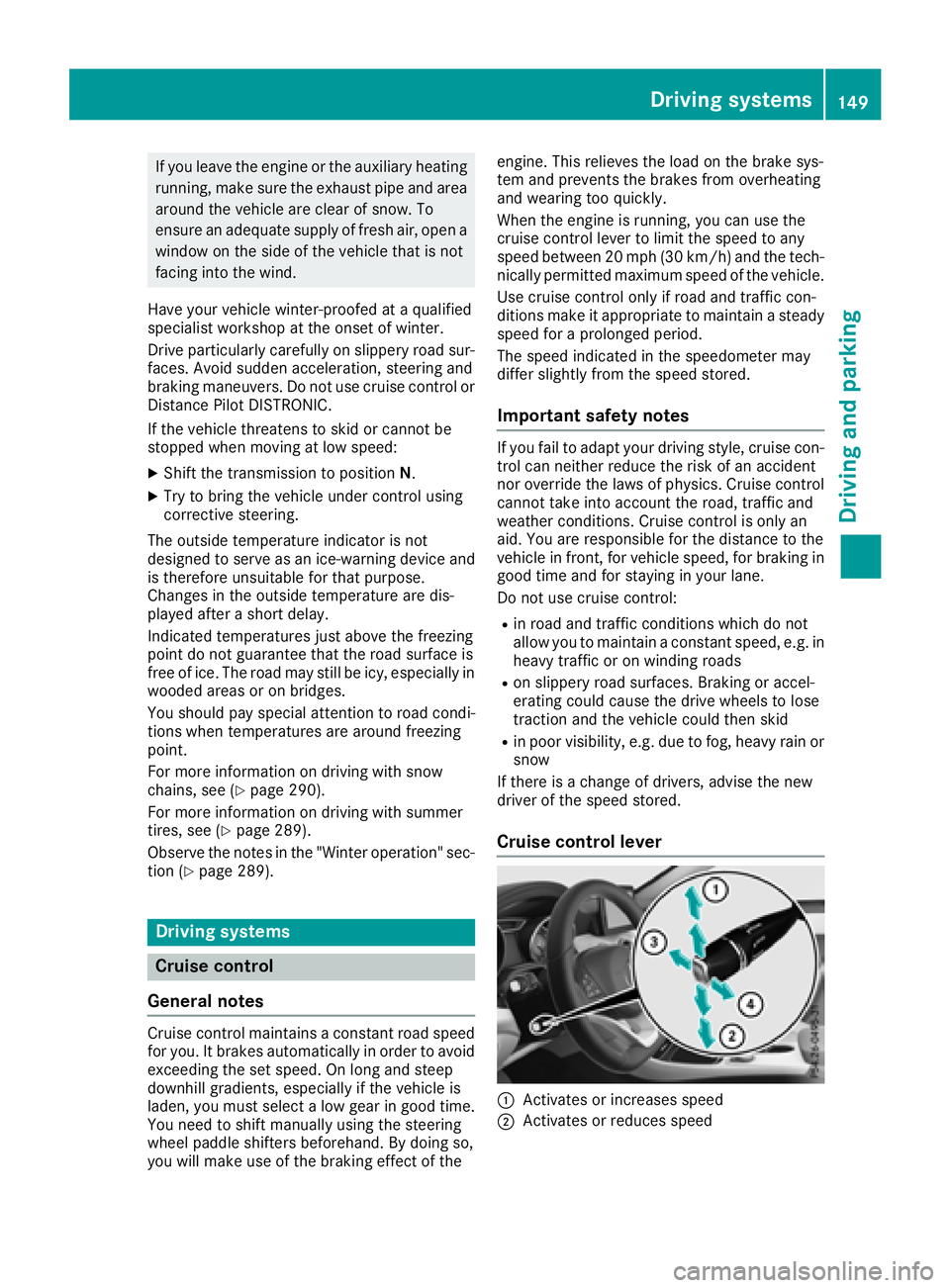
If you leave the engine or the auxiliary heating
running, make sure the exhaust pipe and area
around the vehicle are clear of snow. To
ensure an adequate supply of fresh air, open a
window on the side of the vehicle that is not
facing into the wind.
Have you rv ehicle winter-proofed at aq ualified
specialist workshop at the onset of winter.
Drive particularly carefully on slippery road sur-
faces. Avoid sudden acceleration, steering and
braking maneuvers. Do not use cruise control or
Distance Pilo tD ISTRONIC.
If the vehicle threatens to skid or cannot be
stopped when moving at low speed: X
Shift the transmission to position N .X
Try to bring the vehicle under control using
corrective steering.
The outsid et emperature indicator is not
designed to serve as an ice-warning device and
is therefore unsuitable for that purpose.
Changes in the outsid et emperature are dis-
played after as hort delay.
Indicated temperature sj ust above the freezing
point do not guarantee that the road surface is
free of ice. The road may still be icy, especially in
woode da rea soronb ridges.
You shoul dp ay specia la ttention to road condi-
tions when temperature sa re around freezing
point.
For more information on driving with snow
chains, see ( Y
page 290).
For more information on driving with summer
tires, see ( Y
page 289).
Observe the notes in the "Winter operation" sec-
tion ( Y
page 289).
Drivin gs ystems
Cruise control
General notes
Cruise control maintains ac onstant road speed
for you .Itb rakes automatically in order to avoid
exceeding the set speed .Onl ong and steep
downhill gradients, especially if the vehicle is
laden, you must select al ow gear in good time.
You need to shift manually using the steering
wheel paddle shifters beforehand. By doing so,
you wil lm ake use of the braking effect of the engine. This relieves the load on the brake sys-
tem and prevents the brakes from overheating
and wearing too quickly.
When the engine is running, you can use the
cruise control lever to limi tt he speed to any
speed betwee n20m ph (30 km/h )a nd the tech-
nicall yp ermitted maximum speed of the vehicle.
Use cruise control only if road and traffic con-
ditions make it appropriate to maintain as teady
speed for ap rolonge dp eriod.
The speed indicated in the speedometer may
differ slightly from the speed stored.
Important safety notes If you fail to adapt you rd riving style, cruise con-
trol can neither reduce the risk of an accident
nor override the law sofp hysics. Cruise control
cannot take into account the road, traffic and
weather conditions. Cruise control is only an
aid .Y ou are responsible for the distance to the
vehicle in front, for vehicle speed ,f or braking in
good time and for staying in you rl ane.
Do not use cruise control: R
in road and traffic conditions which do not
allow you to maintain ac onstant speed ,e .g. in
heavy traffic or on winding roads R
on slippery road surfaces .B raking or accel-
erating could cause the drive wheel stol ose
traction and the vehicle could then skid R
in poor visibility, e.g. due to fog, heavy rain or
snow
If there is ac hange of drivers, advise the new
driver of the speed stored.
Cruise control lever
�C
Activates or increases speed
�D
Activates or reduces speedDriving systems 149
Driving and parking Z
Page 214 of 326
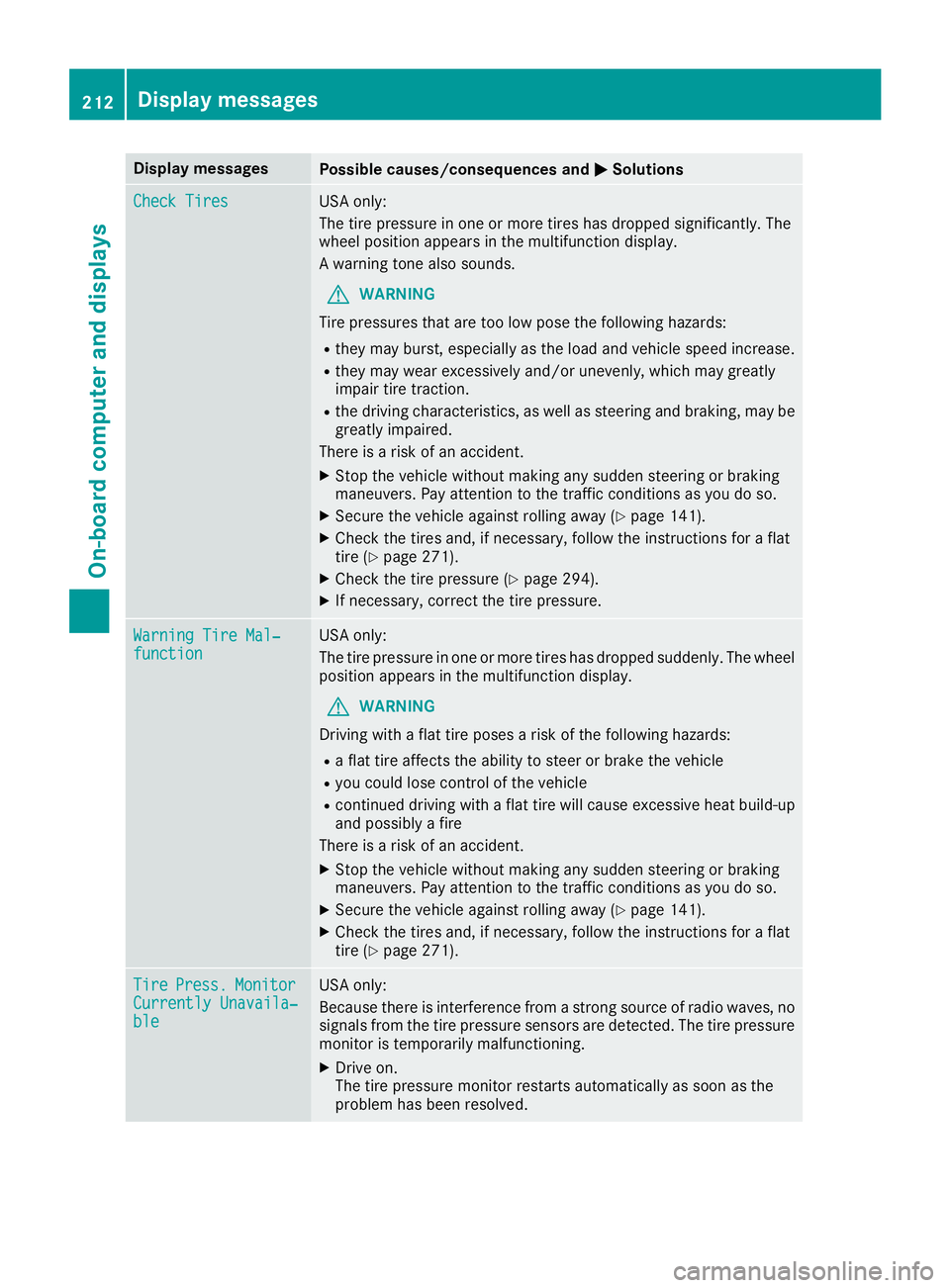
Display messages
Possible causes/consequences and �P Solutions
Check Tires US Ao nl y:
The tire pressur eino ne or mor et ir es has dropped significantly. The
whee lp osition appear sint he multifunction display.
Aw arning tone also sounds.
G WARNIN G
Tir ep ressures that are to ol ow pos et he followin gh azards :R
they may burst, especially as th el oad and vehicl es peed increase.R
they may wear excessivel ya nd/o ru nevenly, whic hm ay greatl y
impair tire traction .R
th ed rivin gc ha racteristics ,asw ell as steering and braking ,m ay be
greatl yi mpaired.
There is ar is kofana ccident.X
Stop th ev ehicl ew ithout making any sudden steering or braking
maneuvers .P ay attention to th et ra ffic condition sasy ou do so.X
Secur et he vehicl ea gainst rollin ga way ( Y
page 141).X
Chec kt he tires and ,ifn eces sary, follow th ei nstruction sf or af lat
tire ( Y
page 271). X
Chec kt he tire pressur e( Y
page 294).X
If necessary, correc tt he tire pressure.
Warnin gT ir eM al ‐
function US Ao nl y:
The tire pressur eino ne or mor et ir es has dropped suddenly. The whee l
position appear sint he multifunction display.
G WARNIN G
Drivin gw it haf lat tire poses ar is koft he followin gh azards :R
af lat tire affects th ea bilit yt os te er or brak et he vehicl eR
you could lose control of th ev ehicl eR
continued drivin gw it haf lat tire will caus ee xces sive heat build-up
and possibl yaf ir e
There is ar is kofana ccident.X
Stop th ev ehicl ew ithout making any sudden steering or braking
maneuvers .P ay attention to th et ra ffic condition sasy ou do so.X
Secur et he vehicl ea gainst rollin ga way ( Y
page 141).X
Chec kt he tires and ,ifn eces sary, follow th ei nstruction sf or af lat
tire ( Y
page 271).
Tir e Press. Monito r
Currently Unavaila‐
ble US Ao nl y:
Becaus et he re is interferenc ef ro mas tr on gs ource of radi ow aves, no
signals from th et ir ep ressur es ensor sa re detected. The tire pressur e
monitor is temporarily malfunctioning .X
Drive on .
The tire pressur em onitor restarts automatically as soo nast he
problem has been resolved.212
Display messages
On-boar dc omputer an dd isplays
Page 291 of 326
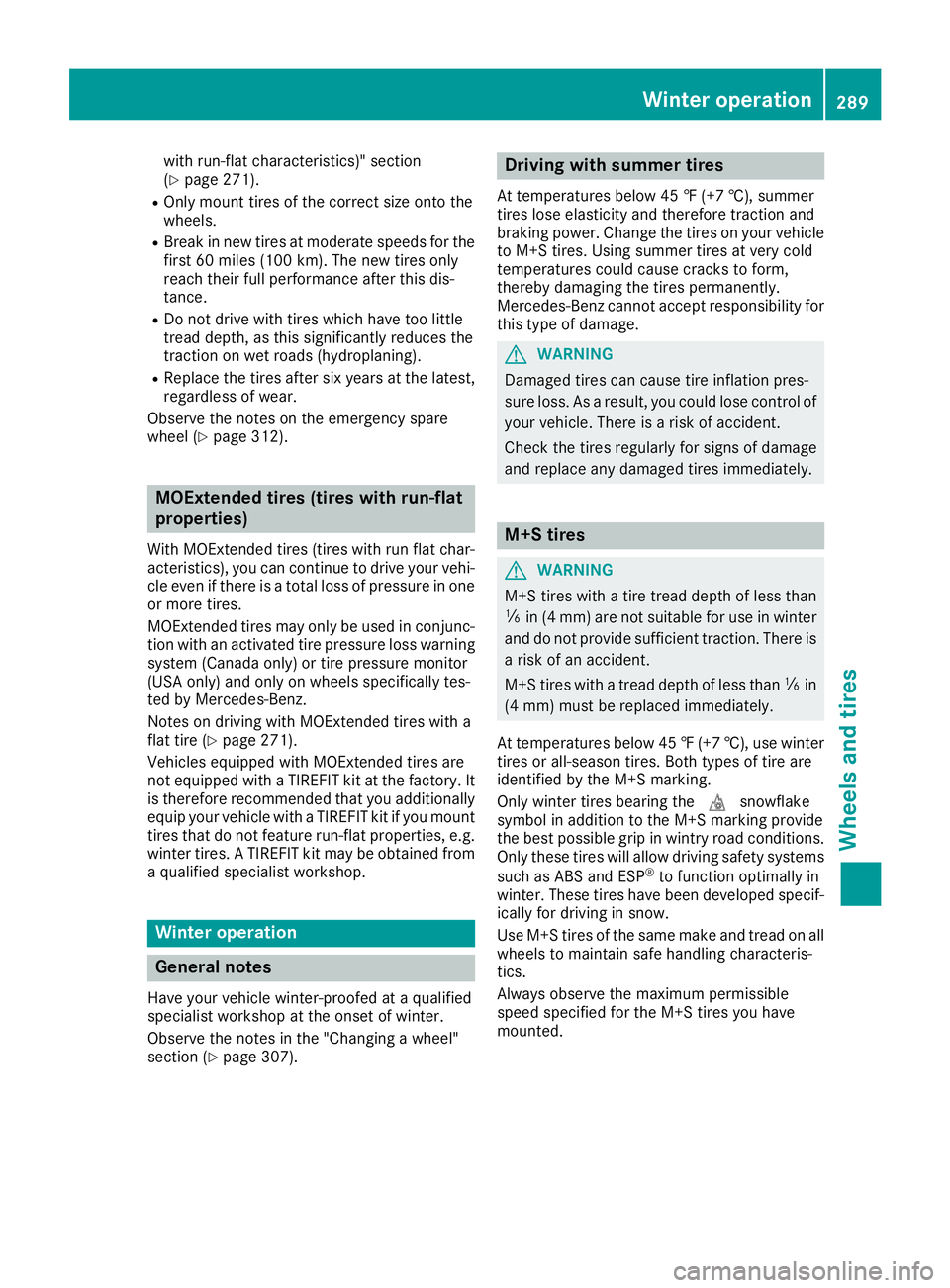
with run-flat characteristics) "s ection
( Y
page 271). R
Only moun tt ires of th ec orrec ts iz eo nt ot he
wheels. R
Break in new tires at moderat es peeds for the
firs t6 0m iles (10 0k m) .T he ne wt ires only
reac ht he ir full performanc ea fter this dis-
tance. R
Do not driv ew ith tires which have too little
tread depth, as this significantly reduces the
traction on wet roads (hydroplaning). R
Replace th et ires after six years at th el atest,
regardless of wear.
Observe th en otes on th ee mergency spare
wheel ( Y
page 312).
MOExtended tires (tires with run-flat
properties) With MOExtended tires (tires with run flat char-
acteristics) ,y ou can continue to driv ey our vehi-
cle even if there is at otal loss of pressure in one
or mor et ires.
MOExtended tires may only be used in conjunc-
tio nw ith an activated tir ep ressure loss warning
system (Canada only) or tir ep ressure monitor
(US Ao nly) and only on wheels specifically tes-
ted by Mercedes-Benz.
Notes on driving with MOExtended tires with a
flat tir e( Y
page 271).
Vehicles equipped with MOExtended tires are
not equipped with aT IREFIT kit at th ef actory. It
is therefore recommended that you additionally
equip your vehicle with aT IREFIT kit if you mount
tires that do not feature run-flat properties, e.g.
winter tires. AT IREFI Tk it may be obtained from
aq ualified specialist workshop.
Winter operation
General notes Have your vehicle winter-proofed at aq ualified
specialist workshop at th eo nset of winter.
Observe th en otes in th e" Changing aw heel"
sectio n( Y
page 307). Driving with summer tires At temperatures below 45 ‡( +7 †) ,s umme r
tire sl os ee las ti cit ya nd therefore traction and
braking power .C hange th et ires on your vehicle
to M+S tires. Usin gs ummer tires at ver yc old
temperatures coul dc aus ec ra ck stof orm,
thereb yd amaging th et ires permanently.
Mercedes-Ben zc anno ta ccept responsibilit yf or
this type of damage.
G WARNING
Damaged tires can caus et ir ei nflation pres-
sure loss .Asar esult, you coul dl ose control of
your vehicle .T her eisar isk of accident.
Chec kt he tires regularly for sign sofd amage
and replace any damage dt ires immediately.
M+S tires
G WARNING
M+S tires with at ir et re ad dept hofl ess than
�
Page 309 of 326
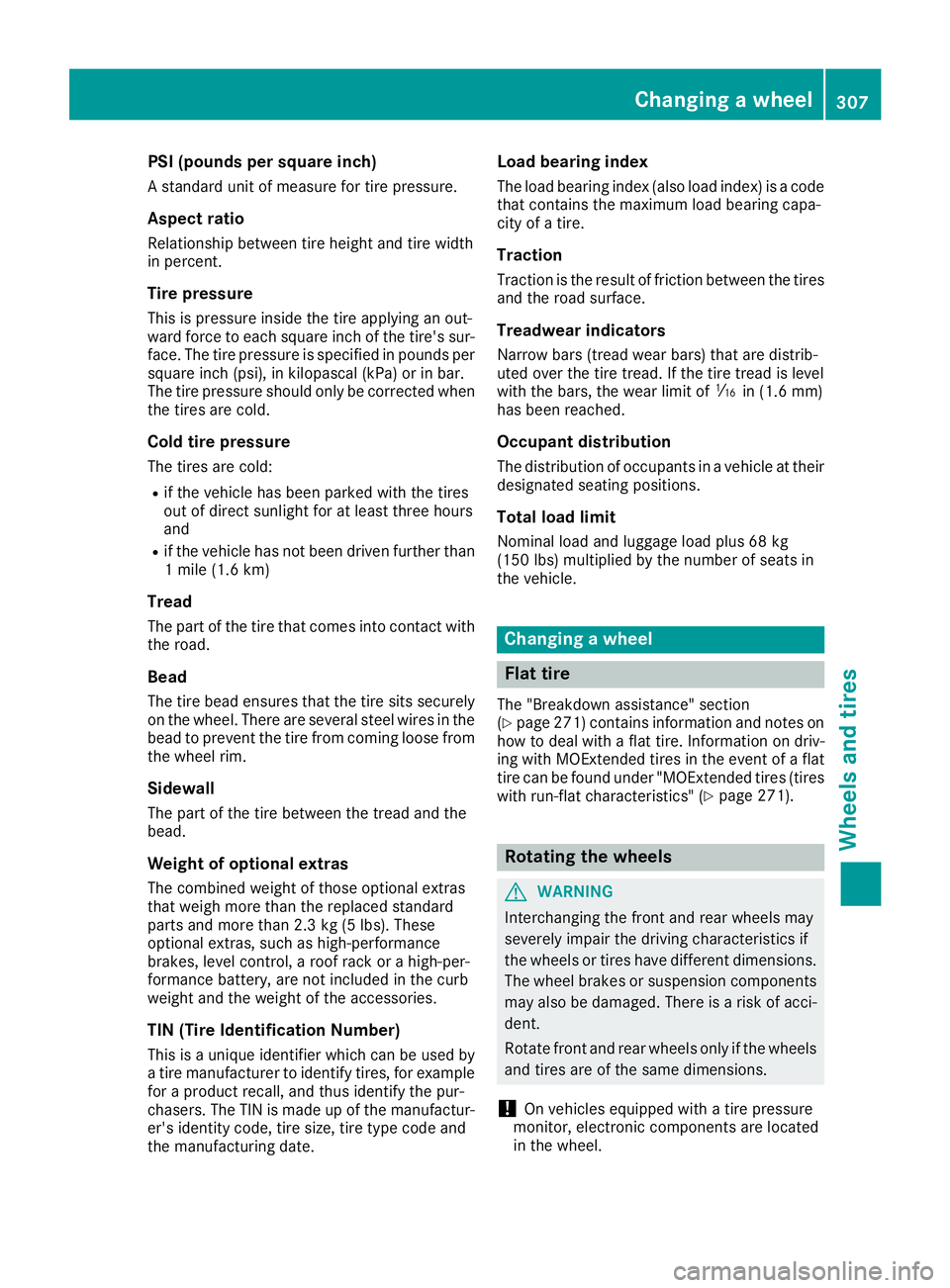
PSI (pounds per squar ei nch)As tandard unit of measure for tire pressure.
Aspect ratio Relationship between tire height and tire width
in percent.
Tire pressure This is pressure inside the tire applying an out-
ward force to each square inch of the tire's sur-
face. The tire pressure is specified in pounds per
square inch (psi), in kilopascal (kPa) or in bar.
The tire pressure should only be corrected when
the tires are cold.
Cold tire pressure The tires are cold: R
if the vehicle has been parked with the tires
out of direct sunlight for at least three hours
and R
if the vehicle has not been driven further than
1m ile (1.6 km)
Tread The part of the tire that comes into contact with
the road.
Bead The tire bead ensures that the tire sits securely
on the wheel. There are several steel wires in the
bead to prevent the tire from coming loose from
the wheel rim.
Sidewall The part of the tire between the tread and the
bead.
Weight of optional extras
The combined weight of those optional extras
that weigh more than the replaced standard
parts and more than 2.3 kg (5 lbs). These
optional extras, such as high-performance
brakes, level control, ar oof rack or ah igh-per-
formanc eb attery, are not included in the curb
weight and the weight of the accessories.
TIN (Tire Identification Number)
This is au nique identifier which can be used by
at ire manufacturer to identify tires, for example
for ap roduct recall, and thus identify the pur-
chasers. The TIN is made up of the manufactur-
er's identity code, tire size, tire type code and
the manufacturing date. Load bearing index The load bearing index (also load index) is ac ode
that contains the maximum load bearing capa-
city of at ire.
Traction Traction is the result of friction between the tires
and the road surface.
Treadwear indicators Narrow bars (tread wear bars) that are distrib-
uted over the tire tread. If the tire tread is level
with the bars, the wear limit of �